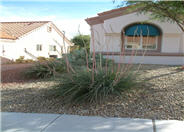
Common name:Red Yucca
Botanical name:Hesperaloe parviflora
This spectacular succulent grows to 3 to 4 feet tall and wide. Blue green leaves are strap-like, leathery, long, with white fraying fibers on the edges. During the summer, dark pink flowers are seen on arching, red stalks, and reach up to 6 feet. Hummingbirds love these flowers. This evergreen plant is drought tolerant once it's established but will appreciate extra water during the summer to promote blooms. Plant in full sun or light shade, with well draining soil. Deer like the foliage.

Common name:Cloth of Gold Yarrow
Botanical name:Achillea filipendulina 'Cloth of Gold'
'Cloth of Gold' is a yarrow cultivar with a stiff, erect habit, growing about 3 to 4 feet tall and about half as wide. It has elegant, deeply-cut, fern-like, deep green leaves. Foliage has a spicy odor when crushed. Flowers are yellow, plate-like, dense, clusters. Good as a cut or dried flower. Long summer bloom period may be extended by prompt removal of faded flower heads. An impressive perennial for a sunny border.
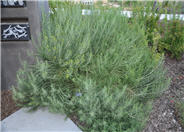
Common name:Rubber Rabbitbrush
Botanical name:Chrysothamnus nauseosus
Rubber rabittbrush is a Utah native, known for its chrome-yellow autumn flowers and strikingly white stems. This plant will reach a mature size of about 4 to 6 feet tall and wide. Fall flowers are chrome-yellow and cover the entire plant. Foliage is long, narrow, grey-green, and slightly hairy, giving it a whitish cast. It is semi-deciduous, and will hold its foliage well into the autumn and early winter. A great shrub for a hot, dry site.
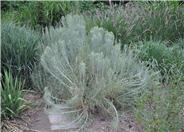
Common name:Big Sagebrush
Botanical name:Artemisia tridentata
Big sagebrush is a Utah native and lives up to its name, growing anywhere from a few to 12 feet tall and 5 to 8 feet wide (the variability is a result of seed source, available water, soil conditions, and other factors that affect growth). It is densed branched with fine textured, silver- to blue-green, aromatic foliage. Inconspicuous yellow flowers appear July through november. The bark is brown, twisted, and scaly. This may not be the ideal sagebrush for a traditional landscape, but it would work well in a naturally-styled setting. Very aromatic.
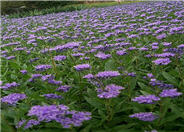
Common name:Blue Mist Shrub
Botanical name:Caryopteris x clandonensis
This group of shrubs grows from 2 to 4 feet tall and up to 4 feet wide. All have a mounded form, with gray green to pale green leaves. Flowers appear in mid to late summer, and appear in a range of blue hues, depending on variety. Flowers are clusters of tiny flowers and mostly form and the tips of branches, so cutting the shrubs back hard in the late winter as new growth emerges makes for more flowers.
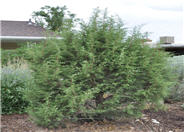
Common name:Utah Juniper
Botanical name:Juniperus osteosperma
A Utah native. this native evergreen grows about 20 feet tall and 10 feet wide. While generally taller than wide, it is still quite rounded in form. Green to olive green in color, with reddish brown cones in the winter. Though Utah juniper is probably the most drought tolerant tree in Utah, in a landscape setting, planted closely with other plants, its water needs are a bit more than it would be in nature. Even so, this is a great low-water evergreen and is a fine evergreen addition to a low water landscape.

Common name:Desert Willow; Desert Catalpa
Botanical name:Chilopsis linearis
Desert Willow is a small, deciduous tree with shrubby inclinations. It grows about 15 to 25 feet tall and nearly as wide, with an open, though twiggy appearance. New bark is green, becoming brown and shaggy as it ages. Leaves are fine-textured, long and narrow, and willow-like. Remarkable, orchid-like flowers of white and pink appear in late spring and continue, to a lesser extent, all summer. It can be pruned as a multi-stemmed, low canopied tree or left more shrubby. There is a specimen at the Greater Avenues Water Conservation Demonstration Garden.
| Designer: Xeriscape Design | Native Style Garden 1 |
Photographer: GardenSoft |
Water Saving Tip:
Apply a layer of mulch around plants to reduce moisture loss.
Choose organic mulches, such as shredded bark, compost or aged sawdust.
